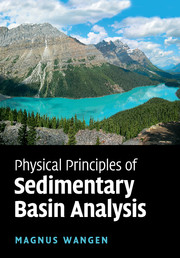Book contents
- Frontmatter
- Contents
- Preface
- Acknowledgments
- 1 Preliminaries
- 2 Properties of porous media
- 3 Linear elasticity and continuum mechanics
- 4 Compressibility of rocks and sediments
- 5 Burial histories
- 6 Heat flow
- 7 Subsidence
- 8 Rheology: fracture and flow
- 9 Flexure of the lithosphere
- 10 Gravity and gravity anomalies
- 11 Quartz cementation of sandstones
- 12 Overpressure and compaction: exact solutions
- 13 Fluid flow: basic equations
- 14 Fluid flow: basic equations
- 15 Wells
- Appendix: Fourier series, the discrete Fourier transform and the fast Fourier transform
- References
- Index
8 - Rheology: fracture and flow
Published online by Cambridge University Press: 07 May 2010
- Frontmatter
- Contents
- Preface
- Acknowledgments
- 1 Preliminaries
- 2 Properties of porous media
- 3 Linear elasticity and continuum mechanics
- 4 Compressibility of rocks and sediments
- 5 Burial histories
- 6 Heat flow
- 7 Subsidence
- 8 Rheology: fracture and flow
- 9 Flexure of the lithosphere
- 10 Gravity and gravity anomalies
- 11 Quartz cementation of sandstones
- 12 Overpressure and compaction: exact solutions
- 13 Fluid flow: basic equations
- 14 Fluid flow: basic equations
- 15 Wells
- Appendix: Fourier series, the discrete Fourier transform and the fast Fourier transform
- References
- Index
Summary
Faulting and folding are important processes that shape the Earth. These different types of deformations reflect two basic types of rheological behavior of rocks – brittle and ductile. Rheology is the study of the deformation and flow of rock under the influence of stress. In the brittle regime the deformation is by fracture and by sliding along fault planes, and in the ductile regime the rock yields. Whether a rock is brittle or ductile depends on temperature and stress. The rock behaves as brittle when the stress needed for brittle deformation (fracture or frictional sliding) is less than for yielding, and vice versa. This chapter presents simple empirical laws that quantify the brittle and the ductile behavior of rocks.
Faults
A fault is a planar fracture where the two sides of the fracture have been displaced relative to each other. The direction of the fault block movement defines three different types of faults, as shown by Figure 8.1. A strike-slip fault is a steeply dipping (near vertical) fault where a horizontal slip has occurred along the strike, as illustrated in Figure 8.1a. Most large strike-slip faults in continental settings are plate boundaries. The two other fault types are dominated by translation directly up or down the dip of the fault plane. The two sides of a non-vertical fault are called the footwall and the hanging wall, where the block above the fault is the hanging wall, and the block below is the footwall. A normal fault results from extension, where the hanging wall moves down relative to the footwall (see Figure 8.1b).
- Type
- Chapter
- Information
- Physical Principles of Sedimentary Basin Analysis , pp. 260 - 281Publisher: Cambridge University PressPrint publication year: 2010



